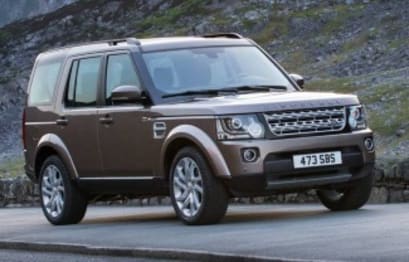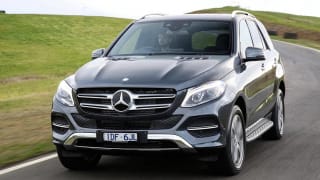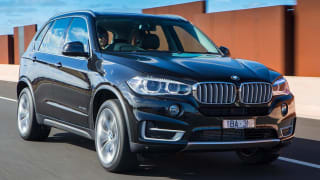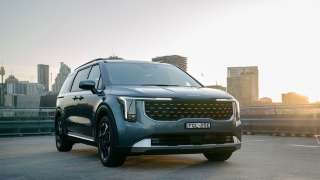The Land Rover Discovery 4 is now entering its seventh year on sale. Given that it’s based very heavily on the Discovery 3, you could almost get away with saying it has been with us for nearly twelve years. That goes back to when we all sniffed at the phrase ‘premium SUV’ and the Defender was a mere whippersnapper nearing its fifth decade.
It may be getting on in years, but the Discovery – or Disco as many of its owners prefer to call it – is still selling strongly, only beaten by Mercedes in its segment in January 2016. It’s on borrowed time but we took the Disco out for a dance to see if it still has the moves.
Value
The Discovery 4 diesel range starts at the TDV6 for $69,360, heading up through TDV6 Graphite, SDV6 Graphite, SDV6 SE and on via the HSE to the Landmark, which tops out at $106,690 before on-road costs. There’s a supercharged petrol if you feel the need, priced from $84,040 through to $95,340 for the HSE.
(These list prices are probably moot as very soon we’ll see the all-new Discovery, meaning deals aplenty on the last of the current model.)
Our SDV6 SE test car weighed in at $84,040 before options. Standard are 19-inch alloys, 11-speaker Meridien stereo with DAB+, USB and Bluetooth, four-zone climate control, keyless entry and start, cruise control, electric front seats, headlamp washers, auto bi-xenon headlights with “signature” daytime running lights, auto wipers, leather trim and auto-levelling air suspension.
Predictably, the options list is long and expensive. Our car was painted in Corris Grey metallic ($1800), had the $5170 Black Pack (20-inch wheels, dark tint and blacked-out lettering and exterior trim) and the $3520 Technology Pack (front and rear sensors and reversing camera, satnav) bringing the total to $92,730. You can spend a lot more.
Design
With the very recent demise of the Defender as we know it, the current Discovery is the last of the Land Rover range not to get the sleek new look that is trickling down from the Range Rovers. It’s a deeply practical-looking design, a vertical nose and tail with lots of tallness in between. A big, imposing car, it delivers with gigantic interior space and Tonka toughness inside and out. It’s also quite slabby, but gets away with it because of the proportions and rugged intention.
The stepped roofline from the original Discovery is still there, with a Range Rover touch in the “floating” roof effect of the blacked out C-pillar. The gigantic rear-vision mirrors look like a pair of extra doors and afford decent vision apart from a fairly hefty over-the-shoulder blind spot.
Inside is cathedral-like, with big comfy chairs up front, three individual chairs in the centre row that slide fore and aft as well as two swing out jump seats in the back that are the least awful third row seats in any SUV. The third row even gets cupholders.
The Disco’s split tailgate is a rarity these days, but very, very welcome. You can open just the glass and then drop down the lower third which makes an excellent workbench for assembling lunch. You can then use it as a makeshift bench seat.
Safety
Six airbags, ABS, brake force distribution and assist, hill descent control, terrain control, rollover stability control and trailer sway control add up to…well, it’s complicated. The current Discovery is effectively a big upgrade to the Discovery 3 which dates back to 2004. That model scored four ANCAP stars in 2006.
It should be noted that the curtain airbags reach all the way to the third row seats.
Features
Jaguar Land Rover’s InControl multimedia system runs the 380 watt 11-speaker stereo as well as the (optional) satnav via a rather tiddly 4.2-inch screen that looks a little lost among the chunky knobs and cliff-face style of the dash.
InControl is rapidly improving with every iteration but this one is still behind the eight-ball. It suffers from the same problem as every InControl implementation in that the touchscreen takes too long to respond. The design and controls are vastly improved from the early versions, though, and are easy enough to learn and remember. You only really have to use the screen when you need the satnav or want to go searching through your music, so that’s something.
Engine
The Disco is powered by a 3.0-litre V6 turbodiesel good for 183kW and a grunty 600Nm of torque (up from 155lkw/520Nm of the TDV6). This will push all 2558kg (!) of Land Rover to 100km/h in 9.3 seconds while delivering a claimed combined fuel figure of 8.8l/100km.
Astonishingly, we got 9.4l/100km in a 70/30 split of city to highway.
The transmission is an eight-speed automatic with a twin-speed transfer box for off-roading duty. It’s rated to tow 750kg of unbraked trailer and a massive 3500kg with brakes.
Driving
For such a heavy car, the Discovery is surprisingly light on its big feet. It’s never going to be a racer (it’s highly unlikely you’ll be disappointed to read this) but is more agile than it looks.
Around the metropolitan areas it feels very large and is a bit of a pain to park, particularly in tighter inner-city spots. The high roof will occasionally cause concern in areas with slack councils who don’t properly trim trees, but it’s easy to manoeuvre once you work out the dimensions.
You sit extremely high in the Discovery in front of a gracefully ageing dash setup. Folks of a certain type will enjoy the captain’s chair feel while others may suffer vertigo – it is a very long way up, with the long flat bonnet accentuating the effect.
Once underway, the lazy V6 diesel is brilliant – great globs of mid-range power mean the Disco belts along the freeway with zero fuss, again belying its weight and less than slim-hipped physique. A run up the Blue Mountains to Katoomba barely saw it shift out of seventh gear up the hill and the hush in the cabin was most impressive.
Very little wind noise penetrates, with just some rustle around the spare doors, er, rear vision mirrors and even the huge 20-inch wheels couldn’t ruin the plush, air-suspended ride. The air-suspension also proves immensely useful when you’re clambering in and out – when dropped to its lowest setting, it’s barely higher than a soft SUV so you definitely won’t need any running boards to help.
Off-road it’s pretty much the benchmark, with a series of terrain settings for the all-wheel drive system and a scarcely believable wading depth of 70cm.



















